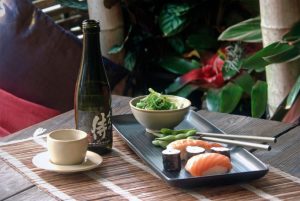
The Master’s wizened face peered intently and piercingly at the delicate scroll hanging on the wall. The sharp, keen glint in his eye belied his aged, frail, 92-year old frame, nestled in a wheelchair. Those eyes stared intently at the bold, jet-black characters that seemed to burst off the thin, delicate paper. After what felt like an eternity a gravelly, impossibly powerful voice emerged from the ancient Master’s throat.
“Outstanding work. Keep it up.”
The Master’s daughter wheeled him to the next work in the exhibition. I attempted to maintain composure as I hastily exited the exhibit hall and immediately burst into tears. I had put every ounce of my heart and soul into that piece of Japanese calligraphy. I’d slaved for months to try to get every brush stroke just perfect. I’d sweated and agonised as I repeated the same four characters over and over with ink-stained hands: 佛心鬼手. The Heart of a Buddha, The Hand of a Demon. The Master’s approval of my raw, far from perfect work brought all that emotion back to the surface.
Chaos Within Order
The phrase itself in some way summarises my feelings about Japan and perhaps tells us a great deal about the Japanese spirit and aesthetic. Put simply; it is an old saying that says that you should be calm and serene inside while pursuing your objectives with vigour and energy. My experience of Japanese calligraphy, or Shodo, as it is known in Japan, kind of correlates with this idea. Turning writing into art is a unique challenge. On the one hand, there is only one correct way to write each character, so you are confined to strict rules or form. On the other hand, if there is no self-expression or unique perspective, it ceases to be art. The true skill and joy of Shodo is in finding your unique artistic voice and mode of self-expression within the strict stylistic confines of the characters themselves.
I always felt that this was highly representative of many aspects of Japanese culture. In many ways, it is a rigid, rule-based society, in which conformity and unity are encouraged, and individuality is frowned upon. However, the more time I spent there, the more I was able to see deeper. I learned to discern that within those rigid societal structures, each individual can find their own way to express themselves. You could say that it is chaos within order.
I Think I’m Turning Japanese
 Japanese style has been immensely popular for decades now in areas as diverse as fashion, food, interior decorating, furniture, and of course, Japanese homewares. If you look closely, you will perceive that within the simplistic, minimalist lines, there is usually an imperfection or lack of symmetry that is at once soothing and confronting. The Japanese call this aesthetic wabi-sabi. It is more a state of consciousness than an aesthetic ideal, and it permeates many aspects of Japanese culture, art and society. Without realising it, I had captured a hint of it in the characters of my calligraphy. They oozed emotion and feeling, while still conforming to the precise rules of form and structure. That, rather than any technical skill, was what impressed the Master.
Japanese style has been immensely popular for decades now in areas as diverse as fashion, food, interior decorating, furniture, and of course, Japanese homewares. If you look closely, you will perceive that within the simplistic, minimalist lines, there is usually an imperfection or lack of symmetry that is at once soothing and confronting. The Japanese call this aesthetic wabi-sabi. It is more a state of consciousness than an aesthetic ideal, and it permeates many aspects of Japanese culture, art and society. Without realising it, I had captured a hint of it in the characters of my calligraphy. They oozed emotion and feeling, while still conforming to the precise rules of form and structure. That, rather than any technical skill, was what impressed the Master.
Bringing Japanese Homewares to Your Home
At Homeware Secrets, it is certainly fair to say that we are huge fans of Japanese style. Our choice range of beautiful Japanese homewares and tableware will bring a delicate taste of wabi-sabi to your space. From our divine selection of Japanese chopsticks to our elegant ranges of Dudson and Santo Alessi tableware, everyone will find something that can put a little hint of chaos into their order.












Leave a Reply